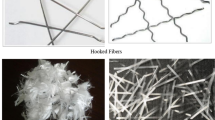Abstract
The rapid technological evolution has leveraged several sectors of the industry, allowing innovations in several levels of performance. The construction sector has been following this transformation, with material innovations, optimization of production processes, and new construction methods emerging on a daily basis, despite being a traditional sector. With the focus on the 4th industrial revolution (Economy 4.0), it is essential to provide the industry with suitable materials to keep up with this evolution, capable of meeting the increasing requirements of performance, durability, and sustainability. As concrete is one of the most versatile materials and used in the construction industry, it is essential to adapt it to the most demanding production methods, namely pre-fabrication, with shorter production cycles, higher automation, unusual shapes (variable, complicated, very slim) and solutions (from traditional to three-dimensional printing based), all challenges for Economy 4.0. In the last decade, particular attention and research effort have been given to high performance and ultra-high performance concretes. These new cementitious matrix materials provide improved performance compared to traditional concrete, both regarding the mechanical properties (allowing smaller sections and manufacturing time, high finish quality of the parts), as well the durability, with significant impact on the life cycle of structures. This optimization allows a reduction not only of the resources required for its manufacture but also a reduction of the environmental footprint and increases the material life cycle. This work deals with this challenge, characterizing a fiber-reinforced self-compacting concrete and showing its advantages, structural performance, impact on the resources used, and maintenance throughout its life cycle.
Access this chapter
Tax calculation will be finalised at checkout
Purchases are for personal use only
Similar content being viewed by others
References
“LiTraCon.” Retrieved from July 15, 2019, http://www.litracon.hu/en.
3D Printed hotel suite. Retrieved July 15, 2019, http://www.3ders.org/articles/20150909-lewis-grand-hotel-andrey-rudenko-to-develop-worlds-first-3d-printed-hotel.html.
Abdullah, M. A. H., Abdullah, N. A. H., & Tompang, M. F. (2018). Development and performance of bacterial self-healing concrete - A review. In 14th International Conference on Concrete Engineering and Technology
Amiri, M., Sardroud, J. M., & Pahlaviani, A. G. (2018). Self-healing concrete and environmental health. International Journal of Epidemiologic Research, 5(3), 107–112.
Anglani, G., Antonaci, P., Gonzales, S. I. C., Paganelli, G., Tulliani, J.-M. (2019). 3D printed capsules for self-healing concrete applications. In 10th International Conference on Fracture Mechanics of Concrete and Concrete Structures.
Arulsivanantham, P., Gokulan, R., D. M. V., K. S., & Achuthan, S. (2015). Bacterial self healing concrete-an innovative repair technique. International Journal of Applied Engineering Research, 10.
Bester, F., Kruger, J., & Zeranka, S. (2019). Benchmark Structures For 3D Concrete Printing.
Buswell, R. A., De Silva, W. R. L., Jones, S. Z., Dirrenberger, J. (2018) 3D printing using concrete extrusion: A roadmap for research. Cement and Concrete Research, 112, 37–49.
Fernandes, P. A. L., Veludo, J., Almeida, N., Baptista, J., Rodrigues, H. (2018). Study of a self-compacting fiber-reinforced concrete to be applied in the precast industry. Innovative Infrastructure Solutions
Fernandes, P., Rodrigues, H., Veludo, J., Baptista, J., & Almeida, N. (2018). Otimização de um betão auto-compactável reforçado com fibras para a indústria de prefabricação. In Betão Estrutural.
Ghodke, P., & Mote, S. (2018). The self-healing concrete—A review. International Journal of Advanced Engineering and Technology.
Le, T. T., Austin, S. A., Lim, S., Buswell, R. A., Gibb, A. G. F., Thorpe, T. (2012). Mix design and fresh properties for high-performance printing concrete. 1221–1232.
Li, V. C., & Herbert, E. (2012). Robust Self-Healing Concrete for Sustainable Infrastructure. Journal of Advanced Concrete Technology, 10, 207–218.
Pegna, J. (1997). Exploratory investigation of solid freeform construction. 5, 427–437.
Sanjayan, J. G., & Nematollahi, B. (2019). 3D concrete printing for construction applications. Elsevier Inc.
Tarhan, Y., & Sahin, R. (2019). Developments of 3D concrete printing process. In International Civil Engineering and Architecture Conference.
Wang, W., Zhong, T., Wang, X., & He, Z. (2019). Research status of self-healing concrete. In International Conference on Civil, Architecture and Disaster Prevention.
Wei, Y., Tay, D., Qian, Y., Tan, M. J. (2019). Printability region for 3D concrete printing using slump and slump flow test. 174.
Yadav, A., Shekhar, S., Anand, A., & Badal, A. (2018). An investigating study on a new innovative material: Transparent concrete. International Journal of Engineering Research and Advanced Development, 4(01), 10.
Zhou, Z. Ou, G., Hang, Y., Chen, G., & Ou, J. (2009). Research and development of plastic optical fiber based smart transparent concrete.
Zieliska, M., & Ciesielski, A. (2017). Analysis of transparent concrete as an innovative material used in civil engineering. In IOP Conference Series: Materials Science and Engineering, vol. 245, no. Imst, p. 7
Author information
Authors and Affiliations
Corresponding author
Editor information
Editors and Affiliations
Rights and permissions
Copyright information
© 2021 Springer Nature Switzerland AG
About this paper
Cite this paper
Fernandes, P., Almeida, N.M.F., Baptista, J.R.S. (2021). The Concrete at the 4th Industrial Revolution. In: Rodrigues, H., Gaspar, F., Fernandes, P., Mateus, A. (eds) Sustainability and Automation in Smart Constructions. Advances in Science, Technology & Innovation. Springer, Cham. https://doi.org/10.1007/978-3-030-35533-3_40
Download citation
DOI: https://doi.org/10.1007/978-3-030-35533-3_40
Published:
Publisher Name: Springer, Cham
Print ISBN: 978-3-030-35532-6
Online ISBN: 978-3-030-35533-3
eBook Packages: Earth and Environmental ScienceEarth and Environmental Science (R0)




